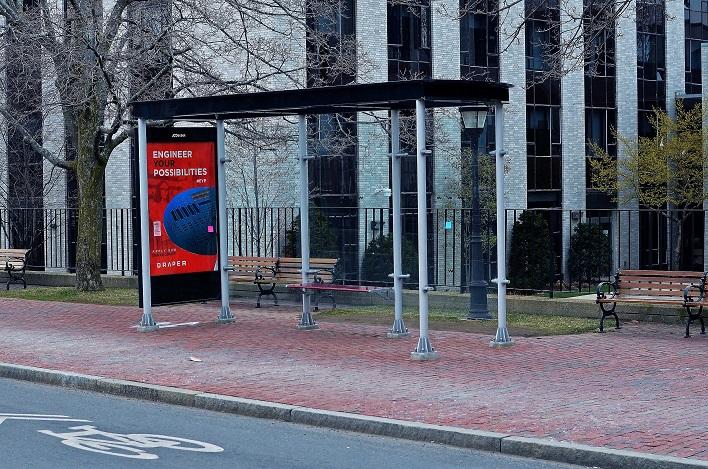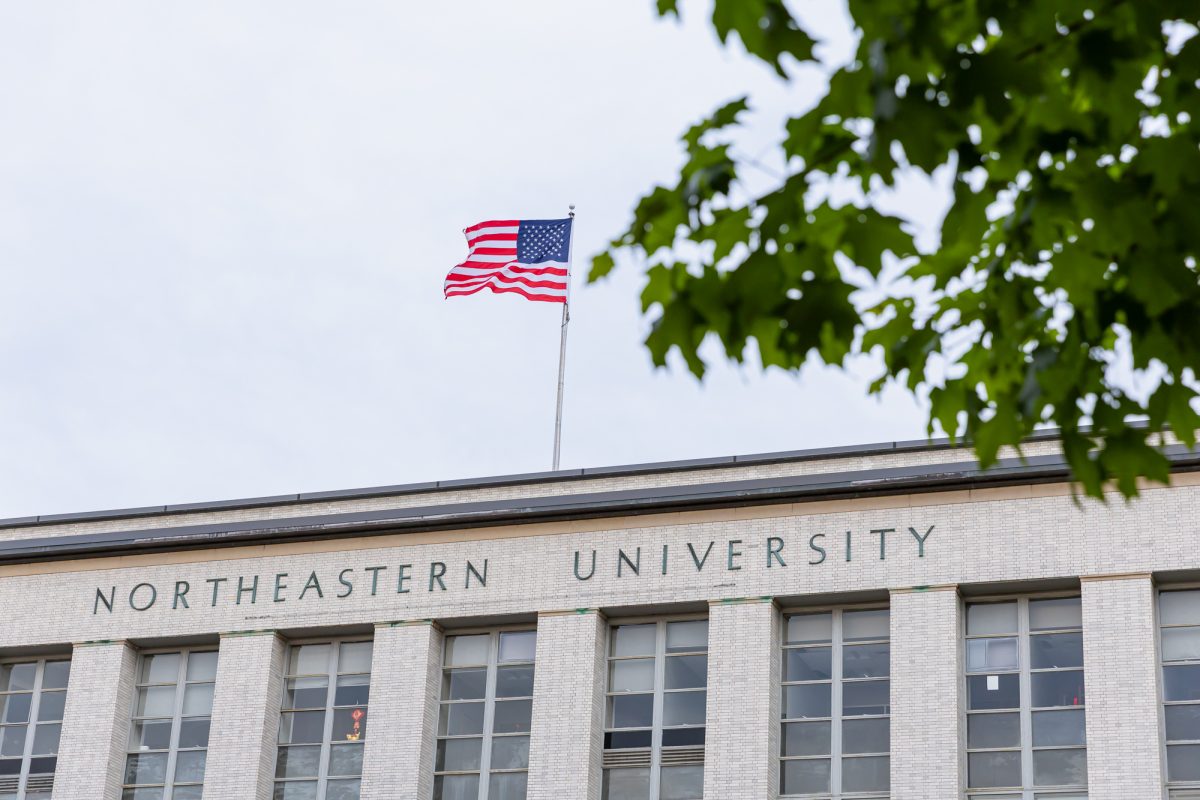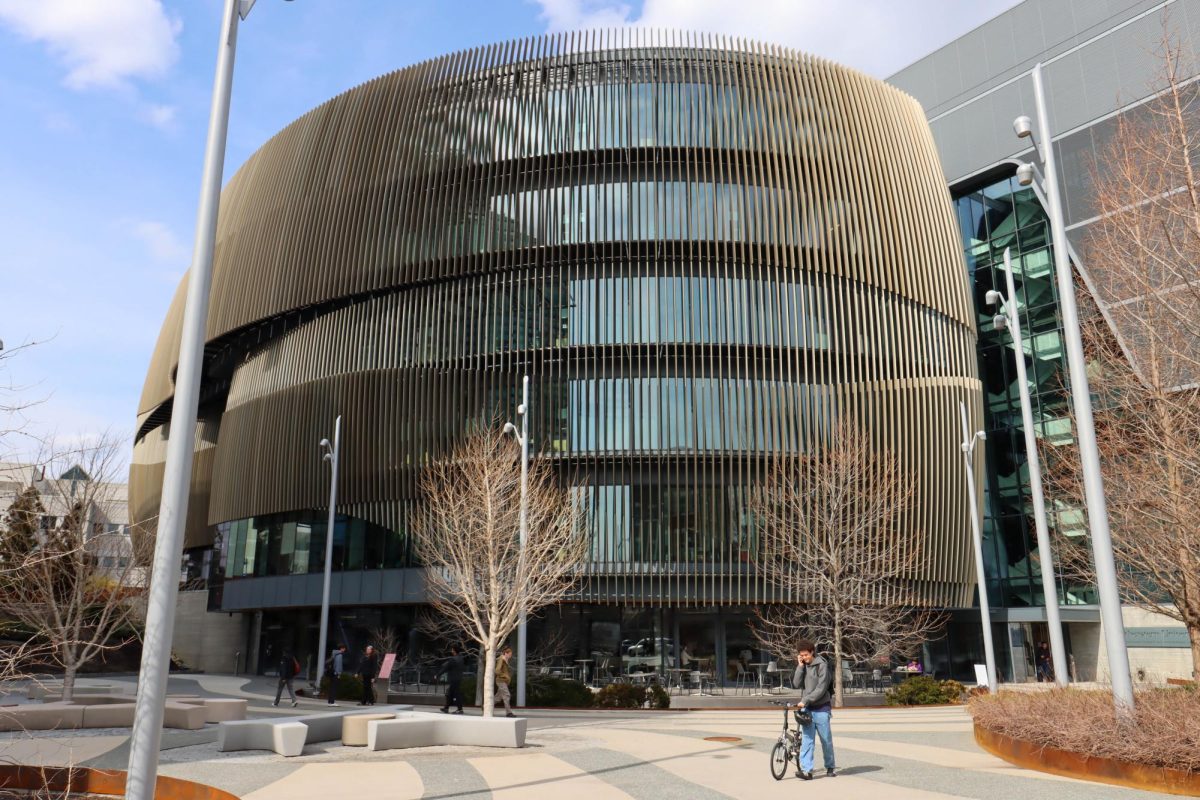By Stephanie Cohn, news correspondent
The unrelenting rain drenched Rayyan Mikati, soaking through her backpack and jacket as she waited alone for the bus. Already one subway ride and a bus ride into her journey, she would soon arrive at her therapist’s heated office. Yet, Mikati would find relief only from the roof over her head – not from the therapy.
“She was just not the therapist for me,” she said. “I came out not feeling any better than I had before, and it just didn’t seem worth it.”
Mikati, a student at Northeastern University who studies biology, ecology and graphic and information design, came to Boston her freshman year with the hopes of recovering from her bulimia nervosa. But the Minnesota native’s rigorous course load drained her, causing her recovery to fall to the wayside. It didn’t help that every day, stepping into the dining hall, Mikati faced an all-you-can-eat buffet, tempting her to give into her compulsion to binge and purge and leaving her to dread every meal.
“It takes a lot of units of energy to resist binging and purging. When I was spending all my energy on classes, I just had nothing left to take care of myself with,” she said.
She knew she needed professional help. Yet, the hour-long commute to her therapist’s office in Brighton led Mikati to question why she even bothered. She remembers how nervous she was to make that first call to Northeastern University Health and Counseling Services (UHCS); how her hands shook as she dialed the number; and how she stared at the green “call” button, wanting to press it but unable to bring her finger to move.
When she finally did press the button, she found out that Northeastern could only offer her one therapy session every five weeks under the condition that it was temporary and the university would help her find a long-term solution. This long-term solution was a referral list of five Boston-area therapists. Two were not accepting new patients, one had moved offices and one was on vacation, leaving her only option a therapist in Brighton, Mass.
Now a junior, Mikati is back at UHCS and sees a therapist she loves. But there’s only room in the therapist’s schedule for her to come in once a month for an hour. Over the entire fall 2015 semester, she has only had three appointments. She asked Northeastern for another referral list, but she was never sent one.
“It’s hard to have so long between appointments because, what do you talk about when you’re there?” she said. “It’s frustrating to not have that support here.”
Counseling Centers under Pressure
In Boston, a city known for its medical innovation and educational institutions, universities proudly display an appearance of caring, using phrases like “you are not alone” and “break the stigma” on pamphlets, posters and websites. However, with an increasing number of college students seeking mental health support, the counseling centers are inundated, leaving students to question just how steadfast the university’s support really is.
In 2015, 35.3 percent of college students said they felt so depressed within the last 12 months that it was difficult to function – a 7.3 percent increase since the American College Health Association’s 2010 report. In addition, a 2014 National Survey of College Counseling Centers reported that 95 percent of college counseling directors said they noticed an increase of students with severe psychological problems.
Without any standardized expectation and with limited resources, Boston-area colleges are scrambling to provide for students.
“It’s purely an issue of funding,” said Paul Polychronis, the director of accreditation of the International Association of Counseling Services (IACS), an organization that certifies high-performing university counseling centers. “I think universities really do value counseling centers very much […] the problem is that it’s always a competition in higher [education] for every dollar spent.”
Without a shared set of standards, the centers have different goals and approaches to helping students.
“In the college mental health area, it’s very, very diverse, and some schools are very well-resourced and some schools really struggle, so you have this lack of consistency,” said Alan Siegal, the Massachusetts Institute of Technology’s (MIT) chief of Mental Health Services for the past 10 years.
Based on IACS standards, colleges should have a ratio ranging from 1,000 to 1,500 students – including graduates and undergraduates – per each full-time equivalent counselor. This number ensures that colleges can better handle students in crisis while also providing support for less urgent concerns. Yet, whether the centers make the ratio or not, they are still criticized by students for their long wait times and limited availability.
At Boston University (BU), which has a ratio of more than 2,000 students per counselor, senior Victoria Pae thinks that getting an appointment at the counseling center is a matter of luck. She, among other students at BU, tried calling the center and never got a call back. Meanwhile, more than 40 percent of students at MIT – 514 students per counselor – were dissatisfied with scheduling appointments at the counseling center, according to the 2015 MIT Healthy Minds Survey.
As Rayyan Mikati experienced at Northeastern – about 2,000 students per counselor – many of the university counseling centers provide only temporary therapy and insurance-based referrals. This means students are often left to hunt for one of the limited number of available therapists in the greater Boston area.
However, Polychronis, of IACS, said students must remember the limitations of college health centers.
“The institutions of higher ed aren’t really meant to function as a health maintenance organization,” Polychronis said. “We’re not providing some sort of care that one would ordinarily need health insurance for.” What the center’s responsibility really should be, he said, is to create an environment that helps students succeed academically and personally.
Schools have different philosophies on how to reach this goal. Some think it’s through the counseling centers, and some, like Alan Siegal, say it’s also “the domain of the entire campus.”
Extending resources beyond the health centers
In her four years at MIT, senior Ariella Yosafat has seen just how much the whole school has come together to improve campus-wide mental health.
She remembers standing at the upper balcony of Lobby 7, the campus’ opulent main entrance hall, and looking down at the crowd gathered at the bottom floor of the building last year. Large groups circulated through the hall each day, but today the crowd wasn’t just passing through. Students, faculty and MIT community members congregated in the lobby as they mourned another student suicide. Yosafat didn’t know the student, nor did many of the people present at the memorial, yet they had all gathered to support the people who did. Seeing the MIT community band together, she knew that a school filled with such compassionate students and faculty deserved better.
“To lose any student is just a horrible, horrible event, and you know as a clinician, you just feel absolutely terrible and you just begin to think about what could I have done,” Siegal said.
Since March 2015, six students at MIT have committed suicide, making the need to improve overall campus health even more crucial.
These deaths have prompted MIT to create the MindHandHeart initiative, a research-driven effort to improve mental health on campus. The program brings together focus groups of students, faculty and administration to research, discuss and create solutions for a wide array of mental health-related problems on campus. Yosafat is one of the student leaders co-chairing the Mental Health and Substance Abuse working group.
“While on a whole we are addressing the issue of mental health, we have different working groups to address it in different possible ways,” Yosafat said. One group is finding out ways to get more students to seek help, and another is trying to relieve some academic stress while still keeping MIT challenging. Yosafat’s group is working to improve the school’s existing resources.
The holistic approach to the program was developed with help from the JED Foundation, an organization focused on suicide prevention in college campuses. Schools in Boston such as MIT, BU and the University of Massachusetts Boston, have joined the organization’s Health Matters Campus Program. The initiative guides colleges through a campus improvement framework with the mindset that mental health should be a campus-wide issue.
MIT’s MindHeartHand initiative has received praise from the MIT community for its innovative and comprehensive approach to improving campus mental health. However, given the high rates of suicide on campus and the wrongful death lawsuits the campus has faced because of that, it begs the question whether fears of liability are prompting more funding toward programs like this.
Katharine Mooney, the director of BU’s Prevention and Wellness Center, thinks that the general American mentality toward health is more reactive than it is proactive which influences funding.
“We’re not really looking at health from a prevention standpoint, and that impacts the resources that we see in higher education,” she said.
At BU, the Prevention and Wellness Center aims to prevent tragedies from ever arising. The center has created initiatives aimed to improve the physical and emotional well-being of its students through programs focused on substance abuse treatment, stress management, sleep and sexual health.
Likewise, in order to help students balance mental illness with academic stressors, Northeastern hired two academic persistence specialists. Their jobs are to help students navigate potentially difficult situations through various means, such as asking professors for flexibility, creating individualized success plans, and providing consistent check-ins. Similarly, MIT has implemented a Student Support Services, also called S3, which provides the same help.
With these programs in place, the question remains as to whether or not this is enough. Some argue it’s not. Some think the students just aren’t accessing the programs.
“I’d say the hardest part is the students themselves who aren’t electing to get help,” Sally Solomon, one of Northeastern’s academic persistence specialists, said. “I don’t think that’s the university’s fault. I just think some students don’t connect.”
Students take on the problem
Rusty Cosino didn’t feel connected his freshman year at Boston College (BC). Struggling with depression and severe anxiety, he was doing everything he could: Meeting weekly with his therapist and taking his medicine. Yet with the overwhelming stress of his declining GPA mixed with family problems at home in California, he felt like he was the only person who hadn’t figured college out.
“I have a really bad habit of isolating myself, keeping to myself, keeping locked up in my room, especially during my first year here,” Cosino said.
Cosino, now a sophomore film major, found his place at BC through a spoken-word poetry group on campus. Nervous to share his personal battle with mental illness, Cosino was inspired to write about it by one of the club’s founders. After listening to his fellow poets perform throughout his first year, he finally gathered the courage to present his work when he was a sophomore.
“Having events where people are basically out there with a helping hand or speaking about their experiences, it just makes a really big difference,” Cosino said, alluding to a recent mental-illness themed poetry event at BC.
Like Cosino, many of the students at the Boston-area colleges think the key to improving mental health on campus is starting conversation about it.
“When we had a number of deaths last year, the response on the students’ part to develop their own initiatives was remarkable. So there’s this sense of really banding together,” MIT’s Alan Siegal said.
Across the city, campus organizations are hosting awareness events like BC’s poetry event to reduce stigma and create an open dialogue about mental illness.
This sort of student-to-student support makes a significant difference. According to a 2009 study out of the University of Texas at Austin, 67 percent of students first tell a friend if they are feeling suicidal.
Utilizing the power of peer support, MIT and BC have also started peer-listening programs, where students are trained by licensed clinicians to provide their fellow students with a safe space to talk about their mental health-related problems. While the programs cannot replace traditional therapy, they give students a person to go to when they are too nervous to see a counselor, just need someone to talk to, or can’t get an appointment.
Although the student groups may help students like Cosino, many still feel isolated by their mental illness.
“[At BC,] I feel like they try to separate the students with mental illness. No one wants to talk to each other about it,” said Jacob, a sophomore at BC who battles with self-harm and wished to withhold his last name for privacy reasons. He thinks the school should sponsor more mental illness support groups on campus run by professionals.
Without help from the administration, students can only do so much. Students like Jacob are left without a support group.
Mikati agrees with Jacob that the school should do more and try to reach more students. She’s noticed that students going to mental health-related events are usually already invested in the topic. It’s the people who need the most educating who don’t attend.
Comparably, colleges are more accepting than the rest of the world, she said, but awareness is still a problem. Mikati notes small insensitivities she’s heard around campus like when “people equate skipping lunch with being ‘soooo anorexic.’”
Students like Victoria Pae – president of BU’s chapter of Active Minds – are trying to do more, but face challenges. When Pae proposed a peer-listening program at BU, the administration denied her request because a faculty member was already crafting a similar program. However, the faculty’s program has been put on hold while the school figures out financials. Pae said the program she had in mind would use pre-existing resources and cost the school no extra money.
BC senior Cassidy Gallegos experienced similar frustrations with the administration at her school. When she was working to start BC’s chapter of To Write Love on Her Arms, a suicide prevention group, she said that a university health center counselor told her that she worried that starting such a group could cause students to develop negative feelings.
“That was hard for me to hear, especially from a counselor who’s supposedly trained and educated, because that statement is just not true and that’s just the stigma of why people aren’t talking,” she said. After explaining to the counselor why the club would help people confronting existing mental illness rather than developing it, Gallegos said the counselor became receptive to her mission.
Through MindHandHeart, Ariella Yosafat has had quite a different experience with administration at MIT.
“People think of the administration as trying to, like, crush them or, like, silence them […] but it’s been really nice to work with the administration and faculty because you can see that they really do care […] and they took the time out of their day to address these issues,” she said, adding that within the working groups, faculty and students have equal say.
Whether the initiatives are student- or faculty-run, they are both working toward the same goal to reduce the shame connected to seeking help. Yet many students who reach out are still left unsupported. Experts argue that the strife of the health centers is merely a product of the national healthcare system.
The National Problem
Jacob, a sophomore at BC, struggled to get an appointment with university counseling even though the school considered him “high risk.” Diagnosed with bipolar II – a less severe type of bipolar disorder – post-traumatic stress disorder (PTSD) and anxiety, and with a history of self-harm, Jacob attempted suicide during his freshman year and was asked to leave the school until he was better. When he returned to BC the next semester, he tried to see a therapist through the school, but before he could even schedule his initial appointment, he had to schedule an intake call to assess his needs. The next available time for a call wasn’t until three weeks after he originally contacted the office. He decided instead to find a therapist on his own.
“It’s very, very hard to get a therapist outside of the school,” Jacob said. “You have to call every place and you have to scour the entire city, and so many don’t have anyone available.” He added that the process of finding a therapist took him about two and a half months.
The college counseling centers are not a substitute for health insurance, IACS Chair Paul Polychronis says. But, he adds, if mental health care were more readily accessible for students like Jacob, the demand for them wouldn’t be so high.
An October 2014 study conducted by Harvard Medical School researchers previously cited by The News found that access to mental health care is very limited. In the study, researchers posed as patients with depression who would offer to pay using BlueCross BlueShield, Medicare or out-of-pocket.
Of the 360 psychologists they called, an estimated 15 percent of the clinics were not accepting new patients, 23 percent of psychiatrists did not return phone calls and 16 percent of the phone numbers listed in insurers’ databases were inaccurate. Researchers were completely unable to schedule any type of appointment 75 percent of the time.
“You’re depressed, you’re suicidal maybe, you feel like the world’s against you and then you summon the strength to make a phone call,” Boyd said. “Then you get wrong numbers and practices that are full and people that don’t return phone calls. It’s dramatically discouraging.”
***
As the questions became more personal, Northeastern student Mikati noticed her voice was shaking. It was her sophomore year, and no one else in Newcope, Northeastern’s eating disorder support group, volunteered to speak at the panel discussion the group was hosting. Mikati decided it was her time to open up. Now, at the event, she felt her confidence waver, but she knew she had to push through.
“I know that somebody here is going to be helped by this kind of information, so suck it up,” she said she told herself throughout the event. “I’m really glad that I did it, but even now looking back, it makes me feel nervous.”
All over Boston, college campuses are hosting events like this, with the goal that they’ll affect someone and that someone in the audience will reach out. And students are indeed reaching out more and more. Last year, the behavioral health clinicians at BU reported that 647 students came into the health center in crisis – more than double the amount of 290 students in crisis that visited the center in the 2010-2011 academic year.
The problem is that these students aren’t guaranteed the support they need.
Add in the 40 percent of students with mental illness who the National Alliance on Mental Illness (NAMI) reports have not sought help through their universities. That is even fewer students who are being accommodated.
However, the infrastructure is there, and for many students, and the system is working. In a 2012 survey from NAMI, of the students with mental illness who accessed college counseling services, 47 percent of respondents rated the support as good and 23 percent rated them as excellent.
“They showed an actual investment into my situation, instead of just figuring out how to get me out of a slump for just this week,” said Cosino, Boston College sophomore, about his experience with the school’s counseling services.
While Mikati, unlike Cosino, was unable to get the help she needed from the counseling center, she still has been able to find support through Newcope. Today, the Northeastern junior is entering her third year of recovery.
By using the resources that the schools have, Katharine Mooney, director of BU’s wellness and prevention center, said they must really emphasize how closely related a student’s mental health is to their academic and professional success.
“In doing that, we are going to get more support in increasing resources for health and wellness,” she said.
MIT is showing just what schools with the right resources can do. The school has assigned behavioral health specialists for each dormitory to provide programming and support. In addition, the school has a peer-listening program, constantly evaluate the health support programs and places no session limit for students who access counseling services. Yet, arguably the school’s biggest innovation won’t cost a cent – student and faculty collaboration.
Siegal said the school’s culture is to come together and solve problems creatively, and that’s how they’ve decided to improve campus-wide mental health.
“It works for us, maybe it could work for others,” he said.
At Northeastern, Mikati stared at the 100 people in the lecture hall. Earlier that semester, she remembers standing out in the freezing rain, feeling hopeless as she waited for the bus. It was surprising that here, on the very same campus that she felt had turned her away, so many people had come to Newcope’s panel to learn about eating disorders. Many people really did care. Yet there was still a disconnect.
“How do we approach a friend that’s been through an eating disorder?” an audience member asked. Mikati poised herself to respond, hoping that if she speaks up, students will stop being left out in the cold.
Photo by Robert Smith















